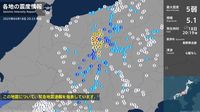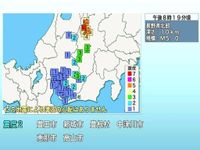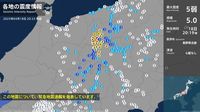On April 18, 2025, at 8:19 PM, a strong earthquake struck Nagano Prefecture, registering a maximum seismic intensity of 5 lower. The Japan Meteorological Agency reported that the epicenter was located in the northern part of Nagano, with a depth of approximately 10 kilometers and a magnitude of 5.1. Fortunately, there is no tsunami threat associated with this earthquake, and an emergency earthquake alert was issued immediately following the tremor.
The hardest hit areas included Omachi City, Ogawa Village, and Chikuhoku Village, all of which experienced the maximum seismic intensity of 5 lower. In addition, seismic intensity 4 was recorded in several other locations across Nagano Prefecture, including Nagano City, Nagano Ikeda Town, Matsukawa Village, Matsumoto City, Azumino City, Aokimura, Asahi Village, and Ikusaka Village.
Seismic intensity 3 was felt in various towns and cities across Nagano Prefecture, while intensity 2 was reported in regions extending beyond Nagano, including parts of Gunma, Niigata, Ishikawa, Yamanashi, Gifu, Shizuoka, and Aichi Prefectures. Seismic intensity 1 was also observed in numerous locations throughout these areas, including Tochigi and Saitama Prefectures, as well as in Tokyo Metropolis and Kanagawa Prefecture.
As residents in the affected areas took stock of the situation, local authorities began to assess the damage. Fortunately, early reports indicate that there have been no significant injuries or casualties resulting from the earthquake. However, officials remain vigilant, as aftershocks are a common occurrence following such seismic events.
In the Tokai region, which includes Aichi, Gifu, and Mie Prefectures, seismic intensity 2 was noted in Takayama City, Nakatsugawa City, and Ena City in Gifu Prefecture, as well as in Toyota City, Shinshiro City, and Toyone Village in Aichi Prefecture. Reports indicate that seismic intensity 1 was felt in a wide area, including Nagoya, without causing any disruptions to transportation services.
Residents of Nagano Prefecture were alerted to the earthquake through an emergency notification system, which successfully informed many of the impending tremors. This system has proven invaluable in past earthquakes, helping to reduce panic and ensure that individuals took necessary precautions.
Despite the earthquake's intensity, the infrastructure in Nagano Prefecture has held up well, with no major structural failures reported as of the latest updates. This resilience can be attributed to stringent building codes and preparedness measures implemented in the region following previous seismic events.
As the night progressed, emergency services continued to monitor the situation closely. Local officials urged residents to remain cautious and stay informed through official channels as they assessed any potential aftershocks that could follow.
In the aftermath of the quake, many residents shared their experiences on social media, expressing their relief that they and their families were safe. Some recounted the moments when the ground began to shake, describing it as a jarring experience that served as a reminder of the region's seismic activity.
Experts from the Japan Meteorological Agency emphasized the importance of preparedness in the face of natural disasters. They recommend that residents regularly review their emergency plans and ensure they have supplies ready in case of future earthquakes.
In addition to personal safety measures, local governments are working to improve public awareness regarding earthquake preparedness. Initiatives include community drills and informational campaigns aimed at educating residents about how to respond during seismic events.
As the situation continues to develop, local news outlets will provide updates on any significant changes or new information regarding the earthquake and its aftereffects. The community is coming together, with neighbors checking on each other and offering support.
While the earthquake has caused some disruption, the overall response from emergency services and local authorities has been commendable. With the right precautions and community solidarity, residents of Nagano Prefecture are demonstrating their resilience in the face of adversity.
In conclusion, the April 18 earthquake serves as a stark reminder of Japan's vulnerability to seismic activity. However, the preparedness and response of both individuals and authorities highlight the strength of the community in navigating the challenges posed by such natural disasters.







